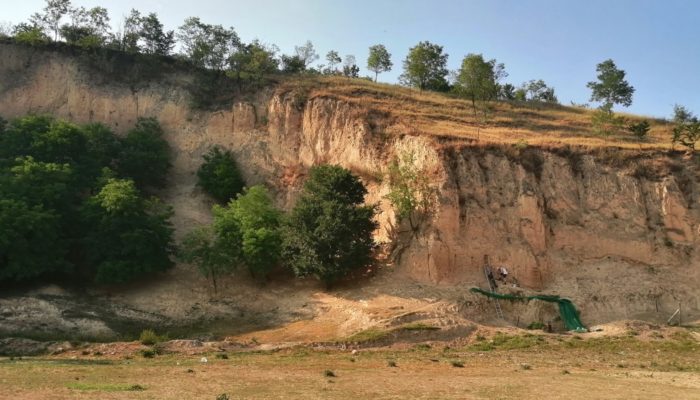
Paleoecological use of land snail shells is no longer a new field of science. They are studied by malacologists and palaeontologists who specialise in the study of molluscs.
During the last glaciation, loess, a light yellow, fine-grained sediment, was deposited over large areas, mainly in the periglacial regions of Eurasia and North America. In addition to its many advantages, it has also provided excellent preservation of land snail shells, which can be studied in spatiotemporal resolution.
The extraction of snail shells from loess is a multi-step process using tap water and solvents to obtain the shells suitable for identification. One of the disadvantages of loess snails is their size, which ranges from 1mm to 3 cm, but most of them are less than 1 cm. Species identification of snail shells is a complex process that considers the morphological characters on the shells and verifies them using identification books and reference materials.

Figure 1. A vial of snail shell from a South Hungarian loess/paleosol section before species identification. You can see the size of the different shells as well.
The paleoecological interpretation is based on the fact that the snails found in loess, which are only a few tens of thousands or even hundreds of thousands of years old, still have descendants living today, which can be studied in their own habitat. Assuming that the ‘older relatives’ had similar habitat requirements and taking into account the percentage distribution of the different species per sample, we can generate an environmental and climate reconstruction.

Figure 2. a) Shells of several snail species under the microscope: Pupilla muscorum. You can find modern specimens in open and sunny habitats, such as dry meadows or grasslands, b) Shells of several snail species under the microscope: Chondrula tridens. The modern specimens of C. tridens are typical in grasslands, and c) Shells of several snail species under the microscope: Vallonia costata (left) and Vallonia tenuilabris (right). The modern specimens of V. tenuilabris can be found in the Altai Mountains nowadays, but during the Pleistocene, they were widespread in the Carpathian Basin as well.
Environmental parameters studied for the snails include temperature, vegetation cover and humidity requirements. If a sample contains a high proportion of warm-loving species that prefer open vegetation, it can be inferred that the environment at the time of deposition of the loess layer containing the sample was an open grassland (steppe) with a comfortable temperature. Following this analogy, a high proportion of species preferring closed vegetation would suggest extensive woodlands, while a high proportion of cold-preferring species would suggest a cold steppe, possibly tundra environment.
Using this methodology on a loess-paleosol section sampled at high resolution (e.g., 4 cm sediment horizons), combined with absolute age data (typically radiocarbon or optical dating), the results can be correlated with global climate curves. By examining samples with the appropriate resolution, we have achieved climate and environment reconstructions with a resolution of a few decades for several loess-paleosol sections along the southern border of Hungary.
This blog was edited by the editorial board.

denis-didier Rousseau
Thank you David for promoting land snails as a wonderful paleoclimatic and paleoecological indicator. Their study goes way back in the literature and surprisingly Quaternary malacology was much more developed in the middle of the previous century than it is now. These organisms are present in many environments among which calcareous tuffs and loess sequences are the best known. However, terrestrial molluscs are not only characteristic of Quaternary deposits either, as they have also been described from Tertiary and Quaternary loess deposits of China, allowing the reconstruction of the Southeast Asian monsoon.
While counting the remains of the various species present in the samples studied can be used to reconstruct past environments, quantitative estimates of past temperature and precipitation can also be given from the counts. In addition, carbon and oxygen isotope studies can also be performed to reconstruct past environments. In addition, variations in the shell size of a single species can characterize variations in the environments in which individuals lived.
Finally, my Chinese colleagues and I recently presented that, in some special cases, snail eggs can also be collected in loess samples, and that their counts also seems to be a surprising paleoecological indicator.
All this to say that terrestrial mollusks are very good paleoecological and paleoclimatic clues that unfortunately deserve much more attention than they currently receive.